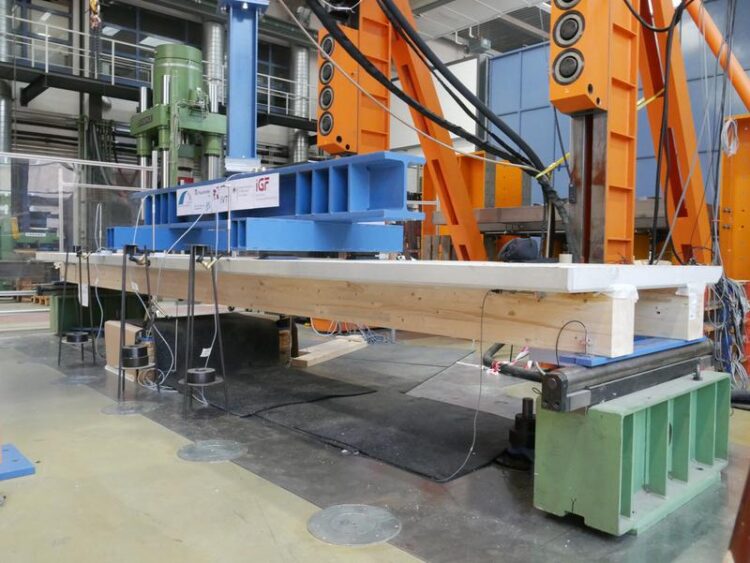Innovative bonding technology facilitates use of timber-concrete composite elements in the construction industry

New rapid-bonding technology enables the safe production of load-bearing timber-concrete composite elements with long span ranges.
Universität Kassel I Jens Frohnmüller
By means of an innovative bonding technology, high-performance timber-concrete composite elements can be produced faster and more easily. As a result of the new joining technology, which was developed by researchers in a cooperative project involving the Fraunhofer WKI, the composite elements become more competitive in comparison to pure concrete elements. The utilization of the renewable raw material wood can therefore be increased in the construction industry.
Timber-concrete composite elements (TCC elements) can be used in multi-story building construction, for example as floor elements. Compared to pure concrete construction and pure wooden construction, they offer a number of advantages. “In the combination of wood and concrete, the specific compression and tensile strengths of the materials are ideally combined. Further advantages of their use include noise insulation and structural fire protection,” explained Malte Mérono, Project Manager at the Fraunhofer WKI. For the TCC elements, spruce or beech wood can be used, which is locally available almost everywhere in Germany. It stores CO2 within the component for a long period of time and reduces the component weight, thereby enabling sustainable lightweight-construction solutions.
Up until now, TCC elements have been connected to one another via, for example, screws or through the casting of fresh concrete onto wooden components. Both methods have disadvantages: The use of screws in TCC elements is very time-consuming, whilst the application of fresh concrete results in an undesirable increased moisture ingress and a longer construction time. In comparison to the pure concrete construction method, TCC elements are therefore not competitive in many locations. In order to change this, researchers from the Fraunhofer WKI, in collaboration with the Institute of Joining and Welding at the TU Braunschweig and the specialist field of “Building Rehabilitation and Timber Structures” at the University of Kassel, have developed a new rapid-bonding technology. It is a fast and simple joining technology for the assembly of TCC elements at the construction site and for the prefabrication in the factory.
The researchers discovered that not only two-component epoxies (2C-EP) but also heat-curing single-component polyurethanes (1C-PU) are suitable for bonding on smooth concrete surfaces. It had been previously assumed that solely sandblasted concrete surfaces were suitable for bonding. It was possible to refute this assumption during the project. The experiments showed that smooth concrete surfaces can be used for bonding in TCC elements, if freshly applied adhesive is embedded between the wood and concrete structure. The original plan within the project was to pre-coat expanded metals with hot-melt adhesive for joint heating and to thereby produce a semi-finished product for the manufacture of TCC elements. “The favored adhesives on a hot-melt basis proved, however, to be unsuitable. Due to the high thermal conductivity of the concrete, insufficient wetting of the concrete surface by the adhesive occurred,” explained Mr. Mérono.
Smooth concrete surfaces can be bonded with spruce and beech wood if release agents are stringently avoided during the concrete production process. Through this procedure, the production of TCC elements becomes simpler and therefore economically more attractive.
In cooperation with the International Association for Technical Issues Related to Wood (iVTH), the relevant expertise and production steps for the application of the hot-bonding technology for TCC elements were summarized in a compact document and can be made available to the industry.
The IGF research project No. 19417 N was funded, via the AiF e. V. within the framework of the program for the promotion of joint industrial research (IGF), by the German Federal Ministry for Economic Affairs and Energy (BMWi) on the basis of a resolution of the German Bundestag. The project was supervised by the International Association for Technical Issues Related to Wood (iVTH) in cooperation with the Deutscher Verband für Schweißen und verwandte Verfahren e.V. (German association for welding and related processes, DVS).
Wissenschaftliche Ansprechpartner:
M.Sc. Malte Mérono
Fraunhofer-Institut für Holzforschung – Wilhelm-Klauditz-Institut WKI
Bienroder Weg 54E
38108 Braunschweig
Telefon +49 531 2155-354
E-Mail malte.merono@wki.fraunhofer.de
Weitere Informationen:
Media Contact
All latest news from the category: Architecture and Construction
Newest articles

NASA: Mystery of life’s handedness deepens
The mystery of why life uses molecules with specific orientations has deepened with a NASA-funded discovery that RNA — a key molecule thought to have potentially held the instructions for…

What are the effects of historic lithium mining on water quality?
Study reveals low levels of common contaminants but high levels of other elements in waters associated with an abandoned lithium mine. Lithium ore and mining waste from a historic lithium…

Quantum-inspired design boosts efficiency of heat-to-electricity conversion
Rice engineers take unconventional route to improving thermophotovoltaic systems. Researchers at Rice University have found a new way to improve a key element of thermophotovoltaic (TPV) systems, which convert heat…



